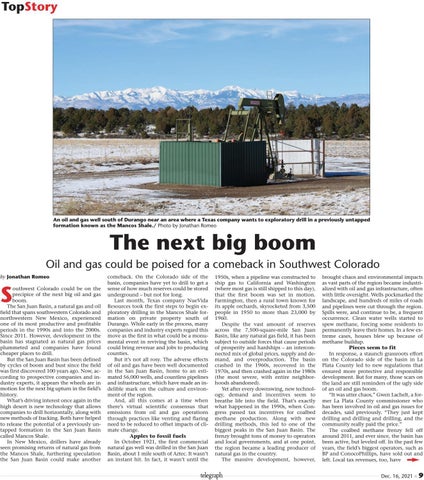TopStory
An oil and gas well south of Durango near an area where a Texas company wants to exploratory drill in a previously untapped formation known as the Mancos Shale./ Photo by Jonathan Romeo
The next big boom Oil and gas could be poised for a comeback in Southwest Colorado by Jonathan Romeo
S
outhwest Colorado could be on the precipice of the next big oil and gas boom. The San Juan Basin, a natural gas and oil field that spans southwestern Colorado and northwestern New Mexico, experienced one of its most productive and profitable periods in the 1990s and into the 2000s. Since 2011. However, development in the basin has stagnated as natural gas prices plummeted and companies have found cheaper places to drill. But the San Juan Basin has been defined by cycles of boom and bust since the field was first discovered 100 years ago. Now, according to prospective companies and industry experts, it appears the wheels are in motion for the next big upturn in the field’s history. What’s driving interest once again in the high desert is new technology that allows companies to drill horizontally, along with new methods of fracking. Both have helped to release the potential of a previously untapped formation in the San Juan Basin called Mancos Shale. In New Mexico, drillers have already seen promising returns of natural gas from the Mancos Shale, furthering speculation the San Juan Basin could make another
comeback. On the Colorado side of the basin, companies have yet to drill to get a sense of how much reserves could be stored underground – but not for long. Last month, Texas company NueVida Resources took the first steps to begin exploratory drilling in the Mancos Shale formation on private property south of Durango. While early in the process, many companies and industry experts regard this move as the first in what could be a monumental event in reviving the basin, which could bring revenue and jobs to producing counties. But it’s not all rosy. The adverse effects of oil and gas have been well documented in the San Juan Basin, home to an estimated 56,000 wells, and countless pipelines and infrastructure, which have made an indelible mark on the culture and environment of the region. And, all this comes at a time when there’s virtual scientific consensus that emissions from oil and gas operations through practices like venting and flaring need to be reduced to offset impacts of climate change. Apples to fossil fuels In October 1921, the first commercial natural gas well was drilled in the San Juan Basin, about 1 mile south of Aztec. It wasn’t an instant hit. In fact, it wasn’t until the
1950s, when a pipeline was constructed to ship gas to California and Washington (where most gas is still shipped to this day), that the first boom was set in motion. Farmington, then a rural town known for its apple orchards, skyrocketed from 3,500 people in 1950 to more than 23,000 by 1960. Despite the vast amount of reserves across the 7,500-square-mile San Juan Basin, like any natural gas field, it has been subject to outside forces that cause periods of prosperity and hardships – an interconnected mix of global prices, supply and demand, and overproduction. The basin crashed in the 1960s, recovered in the 1970s, and then crashed again in the 1980s (the most severe, with entire neighborhoods abandoned). Yet after every downswing, new technology, demand and incentives seem to breathe life into the field. That’s exactly what happened in the 1990s, when Congress passed tax incentives for coalbed methane production. Along with new drilling methods, this led to one of the biggest peaks in the San Juan Basin. The frenzy brought tons of money to operators and local governments, and at one point, the region became a leading producer of natural gas in the country. The massive development, however,
telegraph
brought chaos and environmental impacts as vast parts of the region became industrialized with oil and gas infrastructure, often with little oversight. Wells pockmarked the landscape, and hundreds of miles of roads and pipelines were cut through the region. Spills were, and continue to be, a frequent occurrence. Clean water wells started to spew methane, forcing some residents to permanently leave their homes. In a few extreme cases, houses blew up because of methane buildup. Pieces seem to fit In response, a staunch grassroots effort on the Colorado side of the basin in La Plata County led to new regulations that ensured more protective and responsible development. But for many, those scars on the land are still reminders of the ugly side of an oil and gas boom. “It was utter chaos,” Gwen Lachelt, a former La Plata County commissioner who has been involved in oil and gas issues for decades, said previously. “They just kept drilling and drilling and drilling, and the community really paid the price.” The coalbed methane frenzy fell off around 2011, and ever since, the basin has been active, but leveled off. In the past few years, the field’s biggest operators, such as BP and ConocoPhillips, have sold out and left. Local tax revenues, too, have Dec. 16, 2021 n
9





